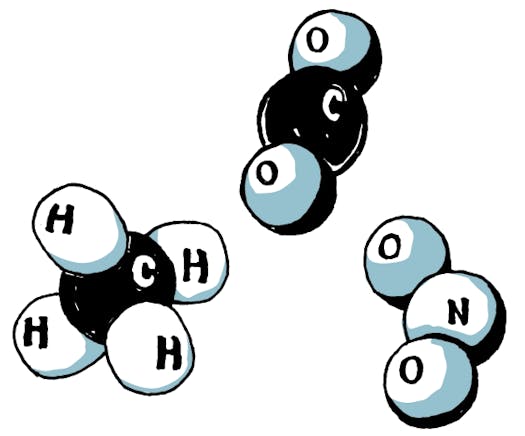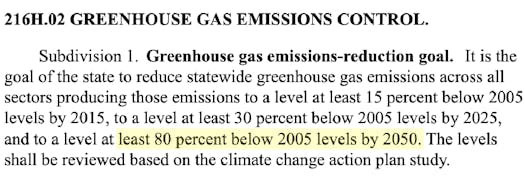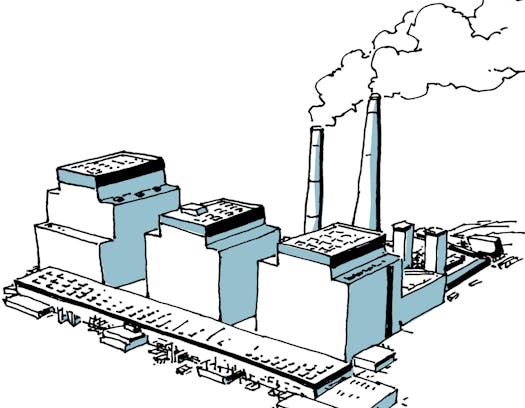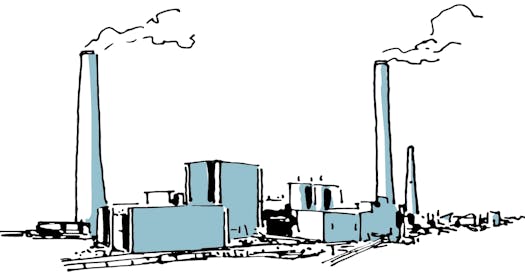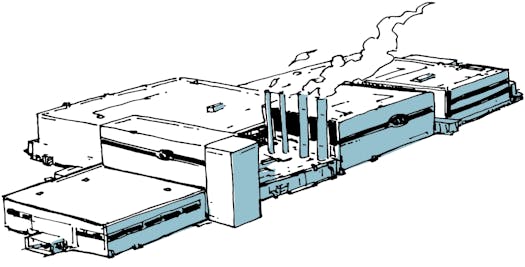These are Minnesota's top greenhouse gas polluters
One hundred facilities in Minnesota are responsible for a quarter of the greenhouse gas emissions in the state. Who are they?
Minnesota's biggest greenhouse polluters form a cross section of the state's economy, providing goods and services deeply embedded in our lives. Electricity. Fossil fuels for heating and cars. Steel. Sugar. Trash disposal. Semiconductor chips. Breakfast cereal.
Most of Minnesota's 19 ethanol plants are on the list, as are many compression stations that push natural gas around the state to heat our homes.
Let's look at what exactly is being measured. The shorthand for the greenhouse gases driving climate change is carbon.
But that really means carbon dioxide, CO2. And in reality, it's not just CO2 but a cluster of the most important gases poisoning the atmosphere and trapping heat: carbon dioxide, methane, nitrous oxide and fluorinated gases. They're most often expressed as a common unit called carbon dioxide equivalents, or CO2e, in metric tons.
The transportation sector — all the jets, cars, SUVs and trucks zooming around — is Minnesota's No. 1 source of CO2e now.
Most of Minnesota's highest emitting facilities fall in three sectors: electricity generation, industrial and commercial. They are called stationary "point sources" because they generate large amounts of pollution from one spot.
Both the U.S. EPA's Greenhouse Gas Reporting Program and the Minnesota Pollution Control Agency have for years required facilities to report these climate-warming emissions. Minnesota's Greenhouse 100 is based on the U.S. EPA data. It tracks emissions from both the combustion of fuels to operate the facility and from specific industrial processes. It doesn't count emissions upstream or downstream from the plant. Also, it doesn't track any emissions from farms or large livestock operations.
Minnesota's Greenhouse 100 pumped about 40 million metric tons of greenhouse gases into the atmosphere in 2019, according to the EPA data. That's about one quarter of the state's total.
The EPA primarily tracks facilities emitting at least 25,000 tons a year. The Minnesota Pollution Control Agency, which uses a different method, collects data from about 1,400 facilities of all sizes down to small businesses. The Star Tribune company emitted 161 tons of greenhouse gases in 2019, the state numbers show.
How much is too much?
Minnesota has a law requiring the state to slash its greenhouse gases by 80% by 2050. The state has so far missed the targets by a wide margin but is trying to get back on track. Hitting them will require extreme cuts. Everywhere.
"One could say any additional quantity of greenhouse gases is important because we know we're already on track to exceed 1.5 degrees [celsius] of global warming — almost certainly two degrees — unless we take dramatic action now," said Michael Burger, executive director of the Sabin Center for Climate Change Law at Columbia Law School.
#1: Xcel Energy's Sherburne County Generating Station (called Sherco) near Becker. The large coal-fired power plant dwarfs all other point sources in Minnesota when it comes to greenhouse gases, emitting 11 million tons in 2019.
That's the equivalent of more than 2 million cars motoring around for a year, according to the EPA. Power generation is the world's top source of greenhouse gases. About a third of Minnesota's top emitters are power plants.
Sherco's emissions have grown about 12% since 2012, the EPA shows. Xcel plans to shutter Sherco by 2026. Considered a national leader in renewable energy, the utility plans to cut its carbon emissions 80% by 2030. That involves retiring all of its coal plants in the Upper Midwest.
#2: Minnesota Power's Boswell Energy Center in Cohasset, in Itasca County. This huge coal-fired power plant's emissions have gone down 8 % since 2012, the EPA data shows. The utility said that's largely because it retired two of the plant's four units. It said it intends to retire a third unit by 2030 and make the fourth unit coal-free by 2035.
#3: Flint Hills Resources Pine Bend Refinery in Rosemount. Flint Hills, owned by Koch Industries, is one of the largest refineries in the Midwest. It refines crude oil into gasoline, diesel fuel and jet fuel. It emitted nearly 4 million tons of greenhouse gases in 2019, up 9% from 2012. Two major changes drove most of the increase, the company said: a new unit to convert the sulfur in crude oil to nitrogen farm fertilizer and a new combined heat and power unit to save on buying electricity from outside.
It's not just power plants and refineries dumping carbon into the atmosphere.
At #89 is Post Consumer Brand's large plant in Northfield. The smell of toasting cereal wafts over the town where the plant churns out more than 45 cereals such as Pebbles, Honeycomb and bags of Tootie Fruities and Marshmallow Mateys. It emitted about 40,000 tons of greenhouse gases in 2019 doing that.
That's up about 3% from 2012 levels, but a Post spokesman said the increase is in line with higher production. The main culprit is burning natural gas for operations. The company said it's trying to control that by being more efficient and minimizing hot water consumption, for example. Post has pledged to cut the greenhouse gases from all of its operations 30% by 2030.
Taken together, emissions from Minnesota's Top 100 have changed little since 2012, edging up about 1.9%, a Star Tribune analysis shows. That mirrors growth in the state's economy.
But emissions rose at more than half the facilities on the list. Sometimes they rocketed.
Landfills pump out high volumes of the climate warming gases. All the organic matter in household garbage piled up at municipal dumps — such as rotting food scraps and yard waste — emit large amounts of methane, a very potent greenhouse gas. But industrial landfills also emit greenhouse gases from materials such as contaminated soil or construction debris.
Greenhouse gas emissions more than doubled at the Vonco II landfill in Becker, #28 on the list, from 2012-2019. The landfill in Sherburne County accepts non-hazardous construction and industrial waste. Owner Veit & Co. said emissions grew primarily due to the landfill's significant growth but also because it started accepting a greater range of industrial waste.
It's still searching for the right technology to help capture Vonco II's greenhouse gases and repurpose it as energy, said Veit General Counsel-Secretary Peter Williams. "It's getting really close."
Sugar beet processers pollute too. Take the Southern Minnesota Beet Sugar Coop in Renville, ranked #12 on the list. The plant washes, slices, cooks and evaporates sugar beets into granulated sugar. It also dries out the beet pulp for animal feed. It emitted 480,507 tons of greenhouse gases in 2019, up about 30% from 2012. That is about how much the plant's production increased over that time too, said Sagar Sunkavalli, the coop's Manager of Environmental Affairs. The plant is constantly trying to save on energy, he said.
The coop hired a consultant to analyze its carbon footprint and determine where it should focus its climate efforts, Sunkavalli said. "We've got to start somewhere."
